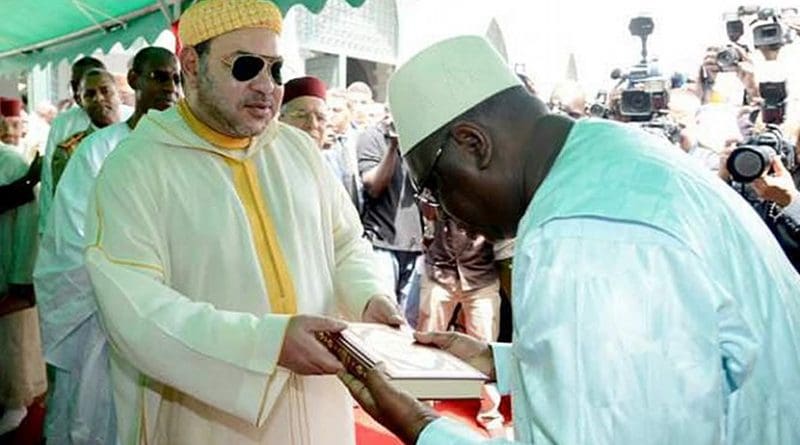Inside Morocco’s Foreign Policy – Analysis
Historical background
Morocco is one of the most ancient political and social entities in the African continent and in the world, its known history is almost 4000 years old, with its Amazigh native population even ruling Egypti as pharaohs in past history.ii It had contacts with the Phoenicians in 1100 BC and, at the same time, its first contact with Judaism brought along with these peaceful merchants.
The Phoenicians established trade centers along the coasts, Lixus on the mouth of the river of the same name , in the north, in the outskirts of the city of Larache. The Phoenicians also built trade centers in Tingis (Tangier), Zili (Asilah), Sala (Salé) and Mogador (Essaouira).
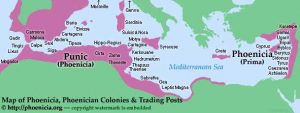
Later on, around 500 BC, the Carthaginians took over these centers and added to them Tamuda, near Tetouan and Ksar Sghir, on the Mediterranean. Very much like the Phoenicians their sole aim was trade and not territory control or political hegemony.
In 146 BC, after the Romans won the Third Punic War, they took over the territories that were under the control of the Phoenicians and as such had their first foreign colonies and became an empire. Morocco was known, then, as Mauretania Tingitana and Volubilis was its capital.
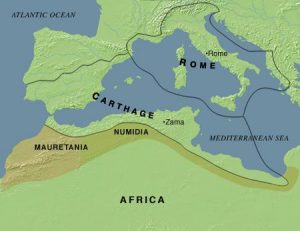
The Romans left quite an imprint on the Moroccan way of life, they taught the native Amazigh (Berbers) sophsticated techniques of agriculture and irrigation and traces of that are still found today in their Tamazight language.iii Their presence lasted until the end of the third century, then Berber tribal chiefs took control of the country until 429 AD when the Vandals arrived with the intention of plunder, but did not stay long because for them there were more riches to acquire in the east.
When Justinian took over the throne of Byzantium, The Byzantines came to Morocco around 527 AD but they could not reestablish the whole Roman empire because the Amazigh had gained in power and military sophistication.iv
Islam arrived in Morocco around 690 AD, and in 711 AD an Amazigh general Tariq ibnou Zayad, at the head of over 30 000 Berber warriors crossed the straight of Gibraltar, that was named after him (Jabal Tariq) and took control of Christian Spain, he renamed al-Andalus. Morocco did not stay long under the eastern Muslim Caliphate, in 740 AD the Islamized Amazigh regained their independence and held on to it since.
Since then, Morocco was ruled by homegrown dynasties, the Idrissids (789-974), the Almoravids (1060-1147), the Almohads (1145-1266), the Marinids (1244-1465), the Wattasids (1472-1554), the Saadians (1549-1659) and the Alaouites (1666-Present).v
Morocco’s Foreign policy in the past (1060-1912)
The Berber Dynasties (1060-1554)
Since the independence of Morocco from the eastern Caliphate in 740 AD, Morocco gained the status of an empire and projected its influence all the way to Ifriquia (Tunisia), Western Africa and Muslim Spain.
In 1031, the Caliphate of Cordoba weakened and collapsed and, as a result, fragmented into a myriad emirates called taifas,vi ruled by weak emirs who sought either to form alliances with the Christian kingdoms, seeking to regain control of Spain, by paying tribute parias for protection. However, in the long run, the situation became intolerable as the emirate of Toledo was literally taken over by the Christian king Alfonso VI in 1085.
In view of this unsustainable situation, the taifas decided to call upon their Muslim brethren in the south i.e. the powerful Almoravid dynasty. This request was officially formulated by al-Mu’tamid in 1086. The Sultan Yusuf Ibn Tashfin, then, moved into Spain to shore up the weak kinglets by pushing back the aggressive Catholic kingdoms of Spain, anxious to reconquer Andalusia.
The Almoravids defeated the Christians under the leadership of Alfonso VI in al-Zallaqavii (Sagrajas) on October 23, 1086 and returned to Morocco, but the latter continued to threaten the Muslims and in 1090 the Sultan Yusuf Ibn Tashfin crossed again the strait and projected there the strength of the Almoravid empire by conquering, this time, al-Andalus and adding it to his empire. Unhappy with this change of heart and policy on the part of the Almoravids, the Muslim kinglets reversed their alliances. In reaction to this suicidal move, the Almoravids took both al-Mu’tamid and Abd Allah of Grenada in exile, in the environs of Marrakesh.

Without the strong action of the Almoravids in Spain, al-Andalus would have fallen to the Christians earlier and history of Islam would have been different today, in that part of Europe.
The subsequent dynasty, the Almohads (1121-1266) lasted longer and held control of Muslim Spain until Muhammad III known as al-Nasser (1199-1214) was defeated by a coalition of Christian kingdoms of Castille, Navarre, Aragon and Portugal, at Las Navas de Tolosa in the Sierra Morena, in 1212. As a result, many taifas fell to the Catholics and Islam remained in very few dominions such as Grenada, until 1492, the time of the final episode of the Reconquista.
Very much like the Almoravids, the Almohads were purists in religious practice, with the difference that the Almohads were intolerant to Jews in Morocco and to, a lesser extent, in Muslim Spain, forcing them to convert to Islam, live under strict dhimmi status or leave their dominions altogether.
As a result of this intolerance, brilliant Jewish intellectuals, such as the philosopher and man of religion Ibn Maymoun, known in the West as Moses Maimonides (1135-1204),viii who was a polymath, revered by both Jews and Muslims for his religious writings, especially his opus The Guide of the Perplexed, written in both Hebrew and Arabic as: dalil al Ha’irin.ix Maimonides was influenced by and influenced several Arab great thinkers and scientists such as: Avicenna, Averroes and al-Farabi.
Because of his fear for his life and that of his family, he went into exile in Fostat in Egypt, that was a more welcoming environment.
At the difference of the mightier Almohads, the Berber Marinids (1244-1465) were more tolerant of other faiths and cultures and opened their empire to people from different religions and cultures.
The Wattasid Dynasty (1472-1554), on the other hand, did not last very long, but saw the influx of migrants from Muslim Spain, both the Jewsx that were kicked out of the country after the fall of the last Muslim emirate of Grenada in 1492 and, of course, the Moors.
The Sephardic Jews were welcomed in Morocco. They were to be known as the megorashimxi (the kicked out Jews), as opposed to the local Jews, the toshavim that migrated to Morocco after the destruction of the Second Temple of Jerusalem by the Romans, in 70 AD. The megorashim settled in the capital Fez, in Tetouan and Marrakesh and in coastal towns like Mogador, Rabat, Salé, El Jadida, Azemmour and Tangier, where they served as interpreters to the invading Spanish and Portuguese powers, as well as, commercial agents tujjar as-sultan and advisors. Others, strong with their experience in politics and statecraft, served as ministers of the sultan, ambassadors or his private advisors or even as his personal physicians.
The foreign policy of the Amazigh dynasties centered around the following concepts :
Assistance to Muslim brethren
The Amazigh dynasties, especially the mighty Amoravids and Almohads, because of their dogmatic belief and purist Islamic faith, crossed several times the Strait of Gibraltar to help Muslim Taifas and check the advance of Christians. Such a move was not only motivated by Islamic brotherhood, but, also, by some sort of a melange of Amazigh and Arab tribal solidarity, known among the Amazigh as:
«Me and my brother against my cousin»
«Me and my brother and my cousin against outsiders »
Or in tribal Arabic philosophy as:
« insur akhaka daliman aw madluman »
(Be on the side of your brother whether he is right or wrong)
However in Muslim faith, assistance to Muslims in danger is a religious obligation on the sultan, commonly known as nusrat al-muslim (assistance to a Muslim) that calls for Jihad in dar l-kufr (the Land of the infidels).
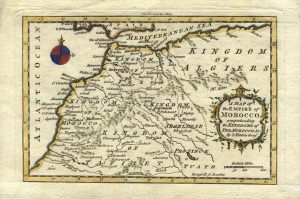
The stabilization and the expansion of the Muslim state
The Amazigh Muslim empire expanded on a north to south axis from Spain all the way to Senegal River and on a west to east axis from the Atlantic shore to Tripoli.
The Amazigh added new territories to the Muslim Caliphate by the way of foutouhat «conquests» in West Africa where the empire of Ghana was defeated by the Amazigh and added to dar al-Islam.
The Sharifian Dynasties (1549-Present day)
The Sharifians dynasties of Saadians (1554-1660) and the Alaouites (1660-present) claimed descent directly from the prophet Muhammad and, as a result, they earned the title of Sharifian meaning «holy» and they were both feared and respected by the population.
During the Saadian dynasty, Morocco experienced tremendous prosperity, especially during the era of Ahmed al-Mansour (1579-1603) to whom the historians added the epithet dahbi, meaning the «golden» because the Moroccan empire experienced a golden era, characterized by stability and prosperity because of all the riches (gold) brought from Africa.
The country developed agriculture, especially sugarcane and exported sugar to England and wheat, barley and maize to France. It, also, increased caravan trade with Africa and benefited from it a lot. Because of the wealth and prosperity of the Saadian empire, art and architecture flourished in the forms of music, dress, architecture and etiquette.
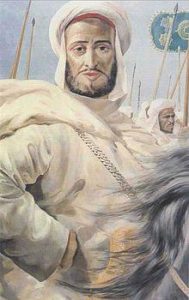
However, soon, the power of the Saadians waned because of internal fighting, palace intrigue and corruption of the ruling elite and were, as such, dethroned by the Alouites who brought religious purism to politicsxii and the concept of baraka «divine grace». Moulay Ali Sherif, who started the Alouite dynasty not only claimed descent from the Prophet shjarah al-muhammadiya (genealogical family tree tracing its origin to the prophet Muhammad), but, also, his divine blessing.
The dynasty, then and now, owes its existence and longevity to two important factors: firstly, religious conservatism doubled by cautious openness to beneficial change and tremendous flexibility in state affairs management characterized by some form of power-sharing through co-optation and power control through coercion.
So, the secret of the survival of the Alouite dynasty in adverse situations through history is their indefectible allegiance to religious conservatism without the rejection of openness and modernization and the nimble use of co-optation and coercion as political tools and the ability to change with the change.
During the reign of the Saadians and the Alouites, prior to the establishment of the French Protectorate, The Moroccan state projected an image of strength and influence, worldwide, through the following actions:
Jihad al Bahr «Jihad at Sea»
Jihad at Sea, was the result of the expulsion of the Moors and the Jews from Spain and later on the Moriscos, many of which settled in the port city of Salé and founded the «Republic of Bouregreg» known in western literature as the «Sallee Rovers» or «Sallee Corsairs».xiii
These pirates, who, had the blessing of the sultan during the 17th century, hijacked British merchant ships in the Atlantic Ocean, brought them to Salé and sold the crew as slaves in the city markets and demanded ransoms for the captain and his team and the notables on the ship. Many British blue-blooded citizens spent years in Salé prisons while awaiting for the British crown to buy them back. The Salé corsaires’ ships went as far as Ireland in their sea-roving activities. Under the pressure of British and European powers, the Alaouite sultan Moulay Slimane (1792-1822)xiv put an end to this piracy, once for all, during his reign.xv
Strengthening of Moroccan imperial image: Recognition of the young American republic
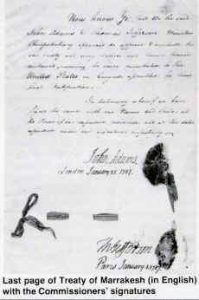
In 1777, Moroccan Sultan Sidi Mohammed III wrote to George Washington, officially recognizing the independence of the United States and offering a Treaty of Peace and Friendship to his young nation.xvi The treaty was ratified by the US Congress in 1787 and remains unbroken, till today. The very same treaty was renegotiated in 1836.
Tangier is the seat of the oldest American diplomatic mission in the world, known as «The American Legation» and is, nowadays, a museum celebrating, in its activities, more than two centuries of solid and unfailing friendship. During WW II, this mission served as a listening room (intelligence gathering) for the Anglo-American military mission known as «Operation Torch» in November 8, 1942, prior to the Invasion of Normandy (D-Day) on June 6, 1944 and the onslaught on the Third Reich in Europe.
Maintaining Moroccan independence
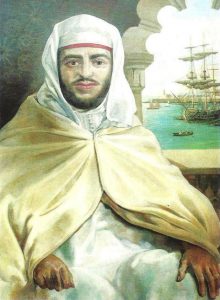
In the 18th and 19th centuries, Morocco tried to maintain its independence in the light of the colonial greed and desire to possess other dominions, expressed by the Ottoman Empire and European colonial powers.
Morocco maintained a diplomatic presence in the Court of St. Jamesxvii in London and in Paris. It had to keep a high profile, on the international scene, because any form of weakness would spur colonial powers for invasion and conquest, especially after Algeria was colonized by the French in 1830, as a result of the fly whisk incident with the Ottomans.
However, Morocco in the light of its Islamic solidarity with the Algerian Emir Abdelkader, fighting a Jihad war against the French, incurred the wrath of the French and leading to the Franco-Moroccan War at Isly near Oujda in 1844 ending in the defeat of Morocco and the end of the myth of the invulnerability of its mighty army. This was followed by another defeat in Tetouan in the war against Spain, in 1959-1860.
Trade with Europe for the sake of friendship and peace
It is a well-known fact throughout Moroccan history that the sultans used the Moroccan Jews for two important inter-related missions: trade and diplomacy. Jews, as early as the Idrissid dynasty in the 9th century, had a tremendous flair for business with foreign nations and the art of diplomacy, and they have certainly served the sultans since, in spite of their demeaning dhimmi status inside Morocco. They became known as tujjar as-sultan «The Merchants of the Sultan»xviii and were always given a special status and, indeed, they played a major role in maintaining the independence of Morocco.
In 1912, Morocco came under French and Spanish colonialism, which was called a protectorate that encouraged indirect control through the religious-political institution of the sultanship, which was 13 centuries old and both loved and feared by the populace.
Moroccan Foreign Diplomacy Under The Three Kings
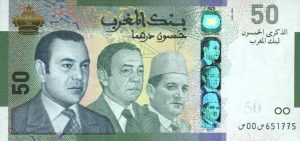
King Mohammed V (1927-1961), King Hassan II (1961-1999) and King Mohammed VI (1999-present), all maintained, through almost a century, a foreign policy philosophy making of Morocco a friendly state to the whole of the world: close to the West and sharing with it the values of freedom and democracy, close to the Arab-Islamic world because of the linguistic and religious substratum and anchored to Africa as a result of geography and shared values of religion and trade benefits.
Morocco today, because of its moderation, openness and international responsibility has navigated safely through the Arab Spring tempest, the Radical Islamic Revival sandstorm and the awesome globalization tsunami. Many people, see Morocco as a model to the Muslim world and as an example to follow by developing counties.xix
Today, the Moroccan foreign policy centers around the following fields:
Alliance with America
Since independence in 1956, Moroccan-American relations have gone crescendo and are today exemplary in spite of the on and off minor hiccups. Morocco has a very active military cooperation with the US, as such, war games are conducted by the armies of the two countries every year (African Lion). America has indirectly included Morocco within the NATO as a non-member ally. America is, also, very active in the development of Morocco through ongoing beneficial programs of USAID. Peace Corps has been present in Morocco since 1962 and has contributed to the development of Morocco and an active cultural dialogue between the two nations and MACECE is an important determinant in cultural exchange and cross-cultural communication. Morocco and America are linked by an ambitious trade agreement : the Free Trade Agreement signed in 2004.xx
Cooperation with Europe
Europe is only 15 kilometers away from Morocco, and, in a word, Morocco is its under belly especially in what concerns security. Cooperation with France, Spain, Portugal, Britain, Germany, etc. is very vital for the Moroccan economy. When King Hassan was preparing his son crown prince Sidi Mohammed (actual King Mohammed VI) for the job of a monarch, he instructed him to do his doctorate on the cooperation with the European Union.
Today, the EU has a big stake in the Moroccan economy with France and Spain, in the forefront. Besides the economy, Morocco with its active and well-trained intelligence community is rendering many services to Europe in its fight against terrorism and religious radicalism. As to what concerns clandestine immigration, Morocco gladly serves as a gendarme for Europe, sometimes even against its own interests.
Morocco, model moderate Muslim country
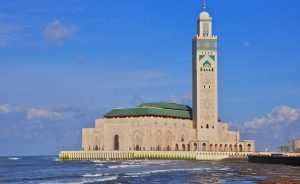
Morocco is definitely an Arab-Muslim country, but very moderate and very open on the rest of the world. xxi
The Monarchy has served for 13 centuries as the symbol of stability by assuming both a temporal role (executive monarchy) and a religious mantle: imarat al-mu’minin (commandership of the faithful).xxii Morocco has sailed successfully throughxxiii the Arab Spring turmoil because back in 1996, Hassan II launched a very important program for incremental democracy and power-sharing and his successor has maintained this progressive devolution of power.xxiv
Positive role in the Arab Israeli conflict
Morocco, because of its millennial relations with Jewry, has developed an understanding for Jewish culture and religion and as such has served successfully in pre-Oslo negotiations between the Palestinians and the Israelis, in bringing their views close to each other. Morocco still continues to play the role of mediator in the on-going conflict.
Development of Africa
Since he assumed power in 1999, King Mohammed VI has been very active in the economic development of Africa. He is all the time visiting personally African nations offering help and launching with them joint win-win economic programs, that will certainly help these countries develop by having access to Moroccan capital as well as know-how and expertise. Today, Maroc Telecom, the major banks and insurance companies, building holdings, etc., are very present in all Africa.xxv Besides, Moroccan universities and higher education institutions welcome thousands of African students, many of whom hold Moroccan scholarships.
Peace-keeping efforts worldwide
Moroccan blue helmetsxxvi are in several parts of the world serving under the banner of the UN to keep peace and give hope to embattled populations. Moroccan army is also present in several Gulf states helping with security and has recently joined the Saudi-led Arab coalition to bring peace and stability to Yemen.
Migration policy
Many African migrants came to Morocco from Africa with the hope to go Europe, but have failed in their efforts so they found themselves stuck in Morocco with no future prospects and no will to return to their poverty-stricken countries of origin. In view of this human tragedy, Morocco voluntarily greeted the migrants an gave them official residence permits, which will allow them to get work for themselves and education for their children besides other social benefits. To date, Morocco is the only Arab country that has a clear migration policy.xxvii
Sahara conflict
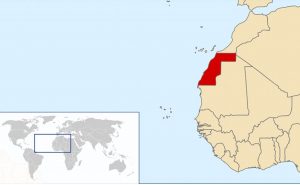
Morocco took control of the Western Sahara in 1975, after Spain vacated this territory on the grounds that the former has religious and political links with the population that was always part of the country prior to dismembering the Moroccan empire by European colonial powers. On the other hand, the Front Polisario claiming to represent the Sahrawi population and armed and funded by Algeria wants Independence. Since the beginning of this millennium Morocco has offered a large autonomy to the territory and the UN is still trying to bring the two sides close together for a negotiated settlement. However, Morocco has developed the small towns and villages of the territory into bustling modern cities with all needed amenities and creature comforts.xxviii
You can follow Mohamed Chtatou on Twitter : @Ayurinu
Endnotes:
i. https://www.temehu.com/imazighen/berbers.htm
ii. Shoshenq I (Shishenk I) ; Berber Pharoah, founder of the Egyptian 22nd dynasty (945-924 BC). His daughter was married to King Solomon, who built a special palace for her.
iii. http://www.ircam.ma/doc/revueasing/mohamed_chtatou_asinag2fr.pdf
iv. The following publications could be consulted for further information on Phoenician, Cartiginian and Roman presence as well as other civilizations in North Africa:
1- The Cambridge history of Africa – By J. D. Fage, Roland Anthony Oliver, A. D. Roberts.
2- Africa in the Iron Age, c500 B.C. to A.D. 1400 By Roland Anthony Oliver, Brian M. Fagan.
3- The fall of the Roman Empire By Peter J. Heather.
v. The following publications could be consulted for further information on the history of Morocco :
1- A Traveller’s History of North Africa, Barnaby Rogerson (available on Amazon).
2- Rome in Africa, Susan Ranen (available on Amazon).
3- The Berbers:The People of North Africa, Michael Brett and Elizabeth Fentress (available on Amazon).
4- The North African Stones Speak, Paul MacKendrick (available on Amazon).
vi. https://www.britannica.com/topic/taifa
vii. It was named al-Zallaqa in Arabic «slippery ground » because the ground was so slippery as a result of the blood shed during the battle.
viii. https://www.britannica.com/biography/Moses-Maimonides
ix. https://www.academia.edu/9650577/The_Chronicles_of_the_Sephardic_Jews_in_Spain_Europe_and_in_Morocco_after_1492
x. http://www.academia.edu/9650577/The_Chronicles_of_the_Sephardic_Jews_in_Spain_Europe_and_in_Morocco_after_1492
xi. https://books.google.co.ma/books?id=sgS1qqkVL0kC&pg=PA46&lpg=PA46&dq=megorashim&source=bl&ots=grOWyrAnZz&sig=8bmqdeXjsgqX81LTWVrekjWSSi4&hl=fr&sa=X&ved=0ahUKEwipovfy_t7YAhXEvBQKHbQZD28Q6AEIRDAE#v=onepage&q=megorashim&f=false
xii. Cf. the theory of the Amazigh founding father of sociology, historiography and demography Ibn Khaldun (1322-1406) in his opus The Muqaddimah (known in the West as Prolegomena) written in 1377, in which he analyzed the growth and decline of empires due to corruption, intrigue and jockeying for power (Cyclical Theory of Empires) and recorded an early view of universal history.
xiii. http://oxfordindex.oup.com/view/10.1093/oi/authority.20110803100438208
xiv. Cf. El Mansour, Mohammed. Morocco in the Reign of Mawley Sulayman. Wisbech: Middle East & North African Studies Press, 1990.
xv. https://www.academia.edu/11157422/UN_APERCU_HISTORIQUE_DES_RELATIONS_ENTRE_LE_ROYAUME_DU_MAROC_ET_LE_ROYAUME_UNI
xvi. https://history.state.gov/countries/morocco
xvii. Ibid
xviii. Cf.Schroeter, Daniel. Merchants of Essaouira: Urban Society and Imperialism In southwestern Morocco, 1844-1886. Cambridge: Cambridge University Press, 1988.
—. The Sultan’s Jew: Morocco and the Sephardi World. Stanford studies in Jewish history and culture. Stanford, Calif: Stanford University Press, 2002.
xix. https://www.gatestoneinstitute.org/4899/morocco-model-for-islam
xx. https://www.google.com/url?sa=t&rct=j&q=&esrc=s&source=web&cd=13&cad=rja&uact=8&ved=0ahUKEwjMzIDXjN_YAhWEvhQKHVtqDLY4ChAWCDMwAg&url=http%3A%2F%2Fwww.worldaffairsjournal.org%2Fblog%2Fmichael-j-totten%2Fwhat-real-alliance-looks&usg=AOvVaw2ZFjoVLoEgKeABFoc_RbEH
xxi. http://www.moroccoworldnews.com/2013/08/101606/coexistence-of-religions-and-cultures-in-morocco/
xxii. http://www.gatestoneinstitute.org/4899/morocco-model-for-islam
xxiii. http://www.academia.edu/10090735/Morocco_riding_Arab_jealousy_storms_successfully
xxiv. Cf. The Constitution of the Kingdom of Morocco of 2011.
xxv. https://www.moroccoworldnews.com/2017/02/207675/king-mohammed-vi-takes-africa-storm/
xxvi. http://medafricatimes.com/5561-ivory-coast-over-700-moroccan-blue-helmets-awarded-un-medal.html
xxvii. https://www.migrationpolicy.org/country-resource/morocco
xxviii. https://www.google.com/url?sa=t&rct=j&q=&esrc=s&source=web&cd=4&cad=rja&uact=8&ved=0ahUKEwjOgp_8kN_YAhXBvRQKHXiiDXcQFghFMAM&url=http%3A%2F%2Fwww.newsweek.com%2Fwestern-sahara-morocco-algeria-polisario-front-435170&usg=AOvVaw0DigWInXcZB86421K4eSJF

